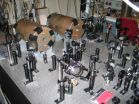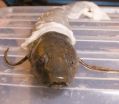(Press-News.org) Chemists at UC San Diego have uncovered a new chemical reaction on tiny particulates in the atmosphere that could allow scientists to gain a glimpse from ancient rocks of what the atmospheres of the Earth and Mars were like hundreds of millions years ago.
Their discovery also provides a simple chemical explanation for the unusual carbonate inclusions found in a meteorite from Mars that was once thought by some scientists to be evidence of ancient Martian life.
"We never knew before how the atmosphere could be trapped in carbonate," said Mark Thiemens, dean of UC San Diego's Division of Physical Sciences who headed the team of scientists that detailed its discovery in this week's early online edition of the Journal of the Proceedings of the National Academy of Sciences. "This chemical reaction, which takes place on the surface of aerosols in the atmosphere, not only provides us with an understanding of how these carbonates can form on the Earth and Mars. It gives us a new tool to better understand climate change, as our planet warms and becomes more dusty."
Robina Shaheen, a postdoctoral researcher in Thiemens' laboratory, discovered the chemical reaction and detailed its importance in the Earth's atmosphere after four years of painstaking experiments in which she found a higher than expected proportion of oxygen 17 isotopes in the carbonates found on dust grains, aerosols and dirt from various parts of the world.
Martian meteorites, such as ALH84001, which was once thought to exhibit evidence of extraterrestrial life, have carbonates with similarly high oxygen 17 anomalies. Scientists have long attributed those anomalies to photochemical processes involving ozone and carbon dioxide in the thin atmosphere on Mars, which is bathed by intense ultraviolet radiation. But after finding similar anomalies on terrestrial carbonates formed in atmospheric aerosols, Shaheen surmised they might be the result of another chemical process more common to both planets.
She analyzed in painstaking detail in the laboratory and in the Earth's atmosphere how ozone molecules interacted with oxygen-bearing mineral aerosols from dust, sea spray and other sources to form hydrogen peroxide and carbonates containing this same oxygen-isotope anomaly.
"What she found is that the tiny little layer on the outside of the grain is where this chemistry all happens," said Thiemens. "It's the ozone in the atmosphere mixing with water and carbon dioxide that drives a completely different kind of chemistry, one that's not in any of the models."
While current models of atmospheric processes assume that the mixing of large volumes of gases drives the chemistry of the Earth's atmosphere, the UCSD chemists think their discovery may force a rethinking of this idea, particularly as the Earth's atmosphere becomes warmer and more dusty, providing more opportunities for this sort of chemistry to take place on aerosols.
"You can do chemistry on a grain that's a lot quicker and easier in many respects than is possible in other atmospheric processes," said Thiemens.
Shaheen, who analyzed the carbonates in the Martian meteorite ALH84001 and found that they could have been formed on aerosols in ancient Martian atmosphere, said that NASA's Phoenix lander recently detected carbonates associated with particulates in the dusty atmosphere of Mars. "We think it might be this same mechanism that is operating," she added.
Besides understanding current and future atmospheric processes on the Earth and Mars, the new discovery offers the possibility of mining information about the Earth's atmosphere, particularly its oxygen levels, from carbonates found in ancient rocks millions of years ago, far beyond the time period from which scientists can now obtain information about the ancient atmosphere from ice cores. The development of this new tool to probe ancient atmospheres could be the most significant aspect of the UCSD chemists' discovery.
"We've found a new way to measure the earth's atmosphere for time periods when we previously could not do it," said Thiemens. "What happened to ozone and oxygen levels 65 million years ago during the Cretaceous-Tertiary period when the dinosaurs and many other forms of life were killed in a mass extinction? Who died first? Did the food chain disappear before the dinosaurs? What happened 251 million years ago during the Permian-Triassic period, the most severe extinction of life on Earth, when 85 percent of life disappeared and no one knows why? There's no record of what happened in the atmosphere. But if you can find a record of what happened to oxygen levels, you can answer questions like that."
INFORMATION:
Other researchers at UCSD involved in the study in Thiemens' laboratory were undergraduates Anna Abramian and John Horn. The research was partially supported by grants from National Aeronautics and Space Administration, the National Science Foundation and the UC San Diego Chancellor's Associates.
Discovery could reveal secrets of ancient Martian and terrestrial atmospheres
2010-11-09
ELSE PRESS RELEASES FROM THIS DATE:
New research shows genetic test for lung cancer risk prompts smokers to quit
2010-11-09
Philadelphia – November 8, 2010 – New research shows a gene-based test for lung cancer risk assessment motivates smokers to quit or cut down, according to results of a clinical study presented today at the American Association of Cancer Research's Ninth Annual Conference on Frontiers in Cancer Prevention Research.
Six months after taking the Respiragene test to identify susceptibility for lung cancer risk, 32% of the randomly recruited smokers in the study had quit smoking altogether and a further 48% had reduced their intake of cigarettes. More than half of the smokers ...
Massachusetts Institute of Technology IDs new cancer drug target
2010-11-09
CAMBRIDGE, Mass. -- Suppressing cancer cells' ability to replicate damaged DNA could dramatically enhance the effectiveness of chemotherapy drugs such as cisplatin, according to a new pair of papers from MIT biologists.
In studies of mice, the researchers found that slowing down a specific system for tolerating DNA damage not only prolonged survival but also prevented relapsed tumors from becoming resistant to chemotherapy, and made tumors much less likely to spread to other parts of the body.
Two enzymes that play key roles in a cell's response to DNA damage could ...
Louisiana State University Health Sciences Center research shows fish oil component given up to 5 hours after stroke limits brain damage
2010-11-09
New Orleans, LA – Research led by Dr. Nicolas Bazan, Boyd Professor, Villere Chair, and Director of the Neuroscience Center of Excellence at LSU Health Sciences Center, has shown that Docosahexaenoic acid (DHA), a component of fish oil, is a powerful therapeutic agent that can protect brain tissue and promote recovery in an experimental model of acute ischemic stroke, even when treatment is delayed by up to five hours. These findings not only target a new stroke treatment approach, but also provide vital information about the length of the therapeutic window. The NIH-funded ...
Scientists make advance in dementia research
2010-11-09
The preservation of a protein found in particular synapses in the brain plays a key role in protecting against vascular dementia after a stroke, say researchers at King's College London.
The study, funded by the Dunhill Medical Trust, is published today in the 9 November issue of Neurology, the medical journal of the American Academy of Neurology. Researchers say the study findings increase understanding of vascular dementia, and highlight a possible target for future diagnoses and treatment of the condition.
Professor Paul Francis, King's College London, said: 'Vascular ...
Hebrew University-developed method for control of malaria applied in Africa
2010-11-09
Jerusalem, November 8, 2010 – Research carried out in Mali, West Africa, has demonstrated that a new, safe and uncomplicated insect control method, developed at the Hebrew University of Jerusalem, can bring about a serious decline in malaria-bearing mosquitoes in afflicted regions in the world.
The research in Africa was based on work carried out earlier in Israel by researchers at the Kuvin Center for the Study of Tropical and Infectious Diseases at the Hebrew University of Jerusalem that showed how attractants of plant origin (fruit or flowers) with a toxic sugar bait ...
Fat cells reach their limit and trigger changes linked to type 2 diabetes
2010-11-09
Scientists have found that the fat cells and tissues of morbidly obese people and animals can reach a limit in their ability to store fat appropriately. Beyond this limit several biological processes conspire to prevent further expansion of fat tissue and in the process may trigger other health problems.
Research funded by the Biotechnology and Biological Sciences Research Council (BBSRC), the Medical Research Council (MRC) and the European Union Sixth Framework Programme, shows that a protein called secreted frizzled-related protein 1 (SFRP1) is produced by fat cells ...
Researchers in Bonn find an 'altruism gene'
2010-11-09
Do you like to do good things for other people? If so, your genes might be responsible for this. At least, the results of a study conducted by researchers of the University of Bonn suggest this. According to the study, a minute change in a particular gene is associated with a significantly higher willingness to donate. People with this change gave twice as much money on average to a charitable cause as did other study subjects. The results have now been published in the journal Social Cognitive & Affective Neuroscience (doi: 10.1093/scan/nsq083).
The researchers working ...
Quantum memory for communication networks of the future
2010-11-09
Researchers from the Niels Bohr Institute at the University of Copenhagen have succeeded in storing quantum information using two 'entangled' light beams. Quantum memory or information storage is a necessary element of future quantum communication networks. The new findings are published in Nature Physics.
Quantum networks will be able to protect the security of information better than the current conventional communication networks. The cornerstone of quantum communication is a phenomenon called entanglement between two quantum systems, for example, two light beams. ...
Graphene gets a Teflon makeover
2010-11-09
Professor Andre Geim, who along with his colleague Professor Kostya Novoselov won the 2010 Nobel Prize for graphene – the world's thinnest material, has now modified it to make fluorographene – a one-molecule-thick material chemically similar to Teflon.
Fluorographene is fully-fluorinated graphene and is basically a two-dimensional version of Teflon, showing similar properties including chemical inertness and thermal stability.
The results are this week reported in the advanced online issue of the journal Small. The work is a large international effort and involved ...
Were our tetrapod ancestors deaf?
2010-11-09
Many changes in the sensory systems of tetrapods are associated with the water-to-land transition. In hearing, one of the crucial elements in detecting airborne sound is the tympanic ear. Surprisingly, the tympanic ear originated independently in the major tetrapod lineages and relatively late after the terrestrial tetrapods emerged – in the Triassic, more than 100 million years after the origin of tetrapods. The major question raised by the researchers Jakob Christensen-Dalsgaard, Christian Brandt and Magnus Wahlberg, University of Southern Denmark, and Maria Wilson and ...


